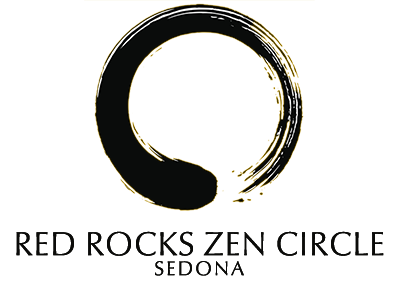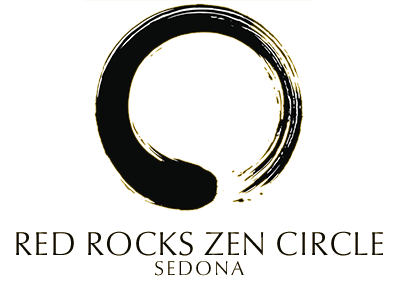On “Opening The Hand of Thought”
Dharma Talk by Deirdre Eisho Peterson
As we were practicing zazen together this morning, I was reflecting on all the different paths that brought us together and first drew us to Zen practice. I’m sure each one of us has our own unique story of how we got here and why we come to the Red Rocks Zen Circle. At the same time, there is probably one common foundation that we share – we all resonate with the teachings in some way, and we believe that they can help us live a more sane and wise and compassionate life in the world.
Whether today is our first day, or whether we have been coming to the zendo for years, we all face the same thing when we sit down on our cushions. We take our seat, away from all the distractions that normally surround us, and we start to let the mind quiet down, to turn the light inward, to really see what this mind-body experience is right now, and to learn how to just be with that experience.
Over the years I’ve heard some interesting anecdotes about the Indian meditation master Munindra-ji. People would travel from all over to ask him the big questions. What is the meaning of life? What is truth? Who am I? And they would want him to give some kind of answer that would resolve their difficulties and their uncertainties. And Munindra-ji would offer the same response: “Oh yes, you want to know who you are, do you? Well, sit down and take a look.”
Sit down and take a look. That’s what we’re doing here this morning, and that’s what I want to talk a little about. It sounds very simple, and it is, but that doesn’t mean it is easy. Because one of the first things we encounter, no matter how long we’ve been practicing, is that our minds are very busy and chaotic. There is a lot of compulsive thinking going on, much of it that we’re only dimly aware of. We’re not very present, meaning we easily lose all contact with being in this room and being in our bodies. We experience a lot of circular, repetitive thoughts, largely about the future and the past, things we’re unhappy about, things we’re worried about. How can we work with this?
A teaching phrase that has been very helpful for me in working with the mind comes from the Japanese Zen master Uchiyama Roshi, an important Soto teacher who died about 10 years ago. Uchiyama Roshi had a great metaphor to help us work skillfully with our mental busyness, to come out of the trance of compulsive thinking. The phrase he used was “to open the hand of thought.” Open the hand of thought. Sometimes we find phrases that really click with us, and there is something about this one, perhaps because it is visual and a bit unusual, that makes it especially powerful.
In clarifying what he means by this phrase, Uchiyama Roshi says this: “When we are thinking, we are thinking of some thing. Thinking of something means grasping that something with thought. During zazen we open the hand of thought that is trying to grasp something, and simply refrain from grasping. This is letting go of thoughts.”
So we have that beautiful image of the hand, how we typically grasp onto thinking, onto inner dialogue, onto all our opinions, keeping a tight fist — when all we need to do is to open that hand. And when we do open the hand of thought, life flows in and flows freely. Life can also flow peacefully, because we have stopped being at war with our experience.
You know, keeping a tight fist takes quite a bit of effort. With the opening of the hand, we relax. Relaxing into the moment is an important part of our practice, just allowing whatever comes up to come up. We can find this relaxation with every breath. We breathe in, and as we breathe out, we relax, we open the hand. And in that open hand, we find – emptiness. Or we could say we find everything – the 10,000 things. We find the moment, just as it is.
This is why Uchiyama Roshi says, “When we let go and open the hand of thought, the Original Self is there. It’s not some special mystical state. Don’t seek it somewhere else. When we open the hand of thought, that is our Original Face.”
So our practice is very much about intimacy. About our direct, first-hand experience. Really, it is quite simple – our moment-to-moment experience, and the knowing of it. There’s a kind of intelligence and wisdom that we awaken through this, one that develops more and more as we continue to practice. When we’re not intimate we can see the things around us rather superficially, as flat, two-dimensional objects. We’ve grasped them with thought, with our opinions, with our calculations of how they will or won’t be useful to us, and we don’t really see them at all. But when we perceive them directly, slowing down enough to pay full attention, then they open up to us in the fullness of their being, whether a stone, a cat or the person sitting on the next cushion.
This is the wisdom at the heart of a teaching from the Tao Te Ching:
Emptied of desire, we see the mystery.
Filled with desire, we see the manifestation of things.
There’s a teaching from Zen Master Joshu that helps us to see this. Some of you may be familiar with this koan about Zen Master Joshu and the Cypress Tree. Sometimes we see this koan in a more abbreviated form, but this morning I want to look at the full dialogue.
A monk asks Joshu, “Why did the first ancestor Bodhidharma come from the West?” This is another way of asking, “What is the essential truth of Buddhism?” or “What is the truth of all things?”
And Joshu replies, “The cypress tree in the garden.” The monk then protests, saying, “You shouldn’t use objects to guide people.” And Joshu replies that he has never used objects to guide people. The monk then repeats his question, “Why did the first ancestor Bodhidharma come from the West?” And Joshu repeats his response, “The cypress tree in the garden.”
Can you see what this koan is pointing to? The monk is very caught up in his many thoughts about what Buddhism is … and is missing the living reality in front of his eyes. When Joshu first replies, “The cypress tree in the garden”, the monk doesn’t really see the tree. He is like all of us can be. He is so busy asking philosophical questions, so wrapped up in his own needs and wants, that he misses the truth that is in front of him in that moment.
When you work with a teacher on this koan, or on any other koan, you are asked to present this living reality, not some explanation of the dialogue, not some philosophical analysis of it. All of that is just moving farther and farther away from it. We’re asked to actually be the koan, to embody it, so there is no separation between the cypress tree in the garden and ourselves, that we are so intimate with our experience that there is just that experience, that sound, or that sensation, without our usual sense of duality, of subject and object. We might briefly experience a moment of consciousness in which subject and object, or we could say that-which-is-seeing and that-which-is-seen, are one. This is why we are continually encouraged to learn to pay attention, to wake up from the virtual-reality in our heads and actually experience what is right here.
The contemporary spiritual teacher Eckhart Tolle has frequently focused on this in his writings. He says this: “Presence is needed to become aware of the beauty and sacredness of nature. You have to put down your personal baggage of problems, of past and future; otherwise you will see but not see, hear but not hear. Your total presence is required. Because beyond the beauty of the external forms, there is more here: something that can not be named, some deep, inner, holy essence. It only reveals itself to you when you are present. Could it be that this nameless essence and your presence are one and the same?” This is a good question for us to explore.
So this is the direction our practice moves. And always, we remember that our practice is not linear. We may go through times where we feel that intimacy that Joshu speaks of is opening up to us, and we may go through times where we feel flat and disconnected. I’ve heard Enkyo Roshi say that our practice, over time, is not a straight line but more like a spiral, that we move through different phases and that we see things and relearn things over and over again, but each time in a different way. So our practice does not have a goal … it is simply to keep noticing, to continue waking ourselves up from the trance of self-centered thinking, and to keep paying attention, whether we are sitting in the zendo or in our everyday life. Really, it is just being sensitive to ourselves and to this life around us, to seeing what is revealed. This is our practice.

